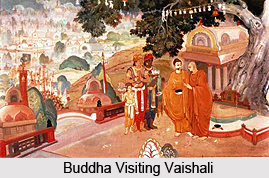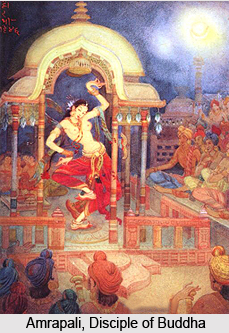 Vaishali is well known for its close association with Lord Gautama Buddha. After leaving Kapilavastu for renunciation, he came to Vaishali first and had his spiritual training from Ramaputra Udraka and Alara Kalama. After the Enlightenment, Buddha frequently visited Vaishali. He organized his Bhikshu Sangha on the pattern of Vaishalian democracy, initiating his maternal aunt Maha Prajavati Gautami into the order. His last Varshavas (rainy season resort) was here and he announced his approaching Mahaparinirvana (the final departure from the world) just 3 months in advance. Before leaving for Kushinagar, where he laid his mortal coil, he left his alms-bowl with the people of Vaishali. The Buddhist Theravadin Commentaries give detailed descriptions of the circumstances of this visit.
Vaishali is well known for its close association with Lord Gautama Buddha. After leaving Kapilavastu for renunciation, he came to Vaishali first and had his spiritual training from Ramaputra Udraka and Alara Kalama. After the Enlightenment, Buddha frequently visited Vaishali. He organized his Bhikshu Sangha on the pattern of Vaishalian democracy, initiating his maternal aunt Maha Prajavati Gautami into the order. His last Varshavas (rainy season resort) was here and he announced his approaching Mahaparinirvana (the final departure from the world) just 3 months in advance. Before leaving for Kushinagar, where he laid his mortal coil, he left his alms-bowl with the people of Vaishali. The Buddhist Theravadin Commentaries give detailed descriptions of the circumstances of this visit.
Invitation by King Bimbisara
Vaishali was inhabited by 7007 kings (rajas) used to live in Vaishali. Each of them had large entourages, palaces and pleasure parks. But after a drought there was the shortage of food and people died in large numbers. The bad smell from decaying corpse attracted the evil spirits and many inhabitants suffered from the intestinal diseases. The people complained to the ruling prince and he convoked a general assembly to discuss about the possible solution. After much discussion everybody came into unison to invite Buddha to their city. That time Buddha was at Veluvana in Rajagriha. That time the Licchavi Mahali who was the friend of King Bimbisara and son of the Chaplin of Vaishali was sent to Bimbisara to request him to persuade Buddha so that he could come to Vaishali. Bimbisara directly referred him to Buddha and Buddha agreed to go to Vaishali after listening to Mahali`s story.
Arrival of Lord Buddha
Buddha started the journey with 500 monks. King Bimbisara decorated the route from Rajagriha to Ganges, a distance of 5 leagues and provided all comforts on the way. The king himself accompanied Buddha and the Ganges was reached in 5 days. Boats were also decorated brilliantly to carry Buddha and his monks. Bimbisara followed Buddha even into the water of the Ganges upto his neck. On the opposite bank of river Ganges, Buddha was received by the Licchavis with greater honour than Bimbisara had shown him. As soon as Buddha set his foot in the Vajjian territory, there was a thunderstorm and heavy rainfall.  The city of Vaishali was located 3 leagues away from the Ganges. As Buddha approached Vaishali, the Sakhyas came to greet him and all evil spirits fled away at the sight of Deva. In the evening Buddha taught Ananda, the Ratna Sutta and ordered him to recite it within the city. The Licchavi princes were asked to take the monk round the city. Ananda did it during the 3 watches of night and the germs of all the severe diseases vanished. Buddha himself recited the Ratna Sutta to the assembled people and 84,000 beings were converted. After repeating this for 7 consecutive days, Buddha left Vaishali. The Licchavis accompanied him to the Ganges with a great honour. On the other bank, Bimbisara was waiting for him. He took him back to Rajagriha. On his return to the Rajagriha Buddha recited Sankha Jataka.
The city of Vaishali was located 3 leagues away from the Ganges. As Buddha approached Vaishali, the Sakhyas came to greet him and all evil spirits fled away at the sight of Deva. In the evening Buddha taught Ananda, the Ratna Sutta and ordered him to recite it within the city. The Licchavi princes were asked to take the monk round the city. Ananda did it during the 3 watches of night and the germs of all the severe diseases vanished. Buddha himself recited the Ratna Sutta to the assembled people and 84,000 beings were converted. After repeating this for 7 consecutive days, Buddha left Vaishali. The Licchavis accompanied him to the Ganges with a great honour. On the other bank, Bimbisara was waiting for him. He took him back to Rajagriha. On his return to the Rajagriha Buddha recited Sankha Jataka.
Last Visit of Buddha
Buddha made several visits to Vaishali. Many Vinaya rules were mentioned as having been laid down at Vaishali. Probably Buddha"s last visit to Vaishali was a long one. In that occasion Buddha ordered the monks to turn their bowls upon Licchavi Vaddha. It was during his stay in Vaishali, when he returned from Kapilavastu, his foster mother Maha Prajavati Gautami followed Buddha with 500 other Sakya women and with the help of Ananda`s intervention got the permission for the women to enter the Buddha Sangha only on the approval to obey certain conditions.
During his last visit to the Capala Cetiya he decided to die within 3 months and informed "Mara". Later he told Ananda about his decision. The next day he left Vaishali for Bhandagama, after having one last look at the city. He turned his whole body round, like an elephant.
Buddha preached many important Suttas at Vaishali like "Mahali", "Cula Saccaka", "Mahasihanada", "Maha Saccaka", "Tevijja", "Sunakkhatta", "Vacchagotta" and "Ratana". After the passing away of Buddha, a portion of his relics was enshrined in the city. After 100 years, Vaishali again became place of interest for Buddhists, on account of the "Ten Points" raised by the Vajjiputtaka and the second Buddhist council held in connection with the dispute at Valikarama.



















